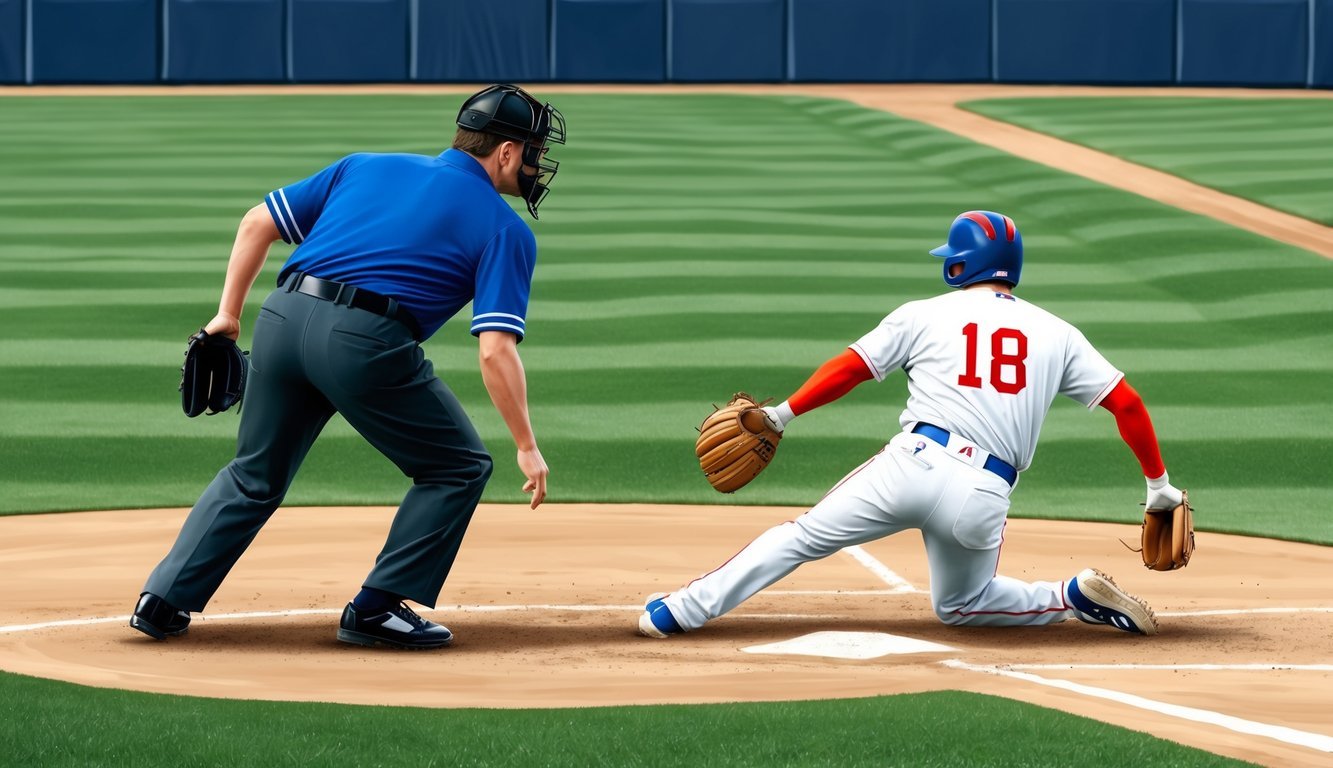Baseball is a game of rules and strategy, with pitchers and batters locked in a constant duel.
One rule that often confuses fans and players alike is the balk. A balk is an illegal motion made by the pitcher that results in all base runners advancing one base.
This rule exists to prevent pitchers from deceiving baserunners.
There are 13 ways a pitcher can commit a balk, ranging from faking a throw to first base to starting and stopping their pitching motion. Umpires are responsible for calling balks, which can have a significant impact on the game’s outcome.
Understanding balks is crucial for pitchers, as well as for fans who want to fully appreciate the intricacies of baseball.
While the rule may seem complex, it ultimately serves to maintain fairness and prevent unfair advantages on the field.
Let’s explore the ins and outs of this important baseball rule.
Understanding the Balk Rule
The balk rule is a key part of baseball that prevents pitchers from deceiving baserunners.
It impacts how pitchers can move and throw when runners are on base.
Origin of the Balk Rule
The balk rule first appeared in baseball’s rulebook in 1898.
It aimed to stop pitchers from using tricky moves to catch runners off guard.
Over time, the rule evolved.
In 2013, Major League Baseball made a significant change.
They banned the fake-to-third, throw-to-first pickoff move, classifying it as a balk.
Before 2013, pitchers could pretend to throw to third base and then quickly toss to first.
This often fooled runners and led to easy outs.
The rule change closed this loophole, making the game fairer for baserunners.
Why the Balk Rule Exists
The main purpose of the balk rule is to maintain balance between pitchers and runners.
It ensures pitchers can’t use deceptive motions to unfairly pick off baserunners.
Without this rule, runners would struggle to take leads or steal bases.
The rule also protects batters.
It prevents pitchers from starting their throwing motion and then suddenly stopping.
This could throw off a batter’s timing and create an unfair advantage.
Such deceptive motions are considered balks, which help ensure a fair competition between pitchers and batters.
By enforcing this rule, the game maintains its integrity and prevents pitchers from using misleading tactics to disrupt a hitter’s focus.
While a well-timed pitch can challenge any batter, a poorly executed one might result in a routine fly ball—often referred to as a can of corn in baseball—making for an easy out.
Umpires play a crucial role in enforcing the balk rule.
They must carefully watch the pitcher’s movements and decide if a balk occurs.
When called, all runners advance one base.
This penalty encourages pitchers to follow the rules closely.
Identifying a Balk
Recognizing a balk can be tricky, even for experienced baseball fans.
Pitchers must follow strict rules about their movements on the mound to avoid deceiving baserunners unfairly.
Pitcher Movements and Balk
A pitcher commits a balk when making an illegal motion while in contact with the rubber.
This includes starting and stopping a pitching motion, faking a throw to an unoccupied base, or failing to step directly toward a base when throwing there.
Key movements to watch:
- Shoulder or hip motion toward home plate before stepping off
- Flinching or sudden stops during the set position
- Dropping the ball while on the rubber, even accidentally
Pitchers in the windup position have fewer restrictions, but must still avoid deceptive movements.
Common Balk Scenarios
Several situations frequently result in balks:
- Quick-pitch: Throwing before the batter is ready
- Fake to first, throw to third (illegal since 2013)
- Failing to pause in the set position
- Switching pitching hands mid-delivery
Umpires also call balks for:
- Pitching while facing away from the batter
- Straddling the rubber without the ball
- Throwing to a base without stepping directly toward it
Remember, intent doesn’t matter.
Even accidental illegal motions can result in a balk call, advancing all runners.
Consequences of a Balk

A balk in baseball leads to immediate effects on the game and penalties for the pitcher’s team.
Let’s explore the specific outcomes when an umpire calls this infraction.
Immediate Effects on the Game
When a balk occurs, the game briefly pauses as a “dead ball” is called.
All runners on base are awarded one base, advancing to their next base without the risk of being tagged out.
For example, a runner on first moves to second, while a runner on third scores.
This can significantly impact the game’s momentum and potentially lead to runs scoring.
If no runners are on base when a balk is called, it’s typically treated as a “no pitch.” The count on the batter remains unchanged, and play resumes as if the illegal motion never happened.
Penalties Imposed for a Balk
The main penalty for a balk is the automatic advancement of runners.
This can be a game-changing event, especially in close contests.
In addition to runner advancement, the offensive team gains an advantage without having to put the ball in play.
In professional baseball, repeated balks may lead to fines or suspensions for pitchers who consistently violate the rules.
Managers might also face consequences if they argue balk calls too aggressively.
In youth leagues, coaches often use balks as teaching moments to help young pitchers improve their mechanics and understanding of the game’s rules.
Infamous Balks in Baseball History

Balks have caused drama and controversy throughout Major League Baseball‘s long history.
From game-changing calls to record-setting infractions, these illegal pitching motions have left their mark on America’s pastime.
Memorable Balk Incidents
Steve Carlton‘s balk in 1972 stands out as one of the most infamous.
The Philadelphia Phillies ace was called for a balk that allowed the winning run to score in the ninth inning against the Atlanta Braves.
Carlton vehemently disputed the call, but to no avail.
In 1963, Bob Shaw of the Milwaukee Braves set an unwanted record by committing five balks in a single game against the Chicago Cubs.
Shaw’s repeated infractions resulted from his struggles to adjust to a new rule about coming to a complete stop during his windup.
Impactful Balks During Games
The 1961 All-Star Game saw a controversial balk call against Stu Miller.
A gust of wind caused Miller to sway on the mound, prompting the umpire to call a balk.
This allowed the tying run to score, and the National League eventually lost the game.
In Game 4 of the 1995 World Series, Atlanta Braves pitcher Steve Avery was called for a balk that allowed Kenny Lofton to advance to third base.
This proved crucial as Lofton later scored the game-winning run for the Cleveland Indians.
A balk by Dodgers reliever Jay Howell in Game 4 of the 1988 NLCS against the Mets allowed the tying run to score.
The Mets went on to win that game, though the Dodgers ultimately took the series.
Common Misconceptions and Clarifications

Balks can be confusing for baseball fans and players alike.
Many misconceptions exist about what constitutes a balk and how to interpret the rules correctly.
Interpreting Pitcher’s Intent
Pitchers don’t always intend to deceive runners when called for a balk.
Sometimes, a slight hesitation or an accidental twitch can trigger a call.
Umpires focus on the action itself, not the pitcher’s motivation.
A common myth is that pitchers can’t fake throws to first base.
In fact, they can, as long as they step off the rubber first.
Another misunderstanding involves the “catcher’s balk.” This isn’t an official term, but it describes a situation where the catcher leaves the box too early during an intentional walk, resulting in a violation.
Balks vs. Legal Moves
Distinguishing between balks and legal moves can be tricky.
Pitchers can make certain movements that may seem deceptive but are actually allowed.
For instance, a quick pitch is illegal, but a quick step-off is not.
Pitchers can fake a throw to second or third base while on the rubber, but not to first.
A legal pitching delivery must be continuous and uninterrupted.
If a pitcher starts his motion and then stops, it’s a balk.
However, slight pauses or hesitations during the windup are often permitted.
The key is consistency – if a pitcher regularly incorporates a pause in their delivery, it’s less likely to be called a balk.
